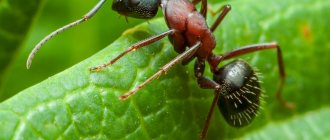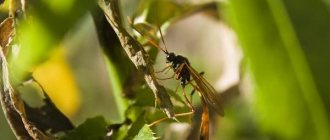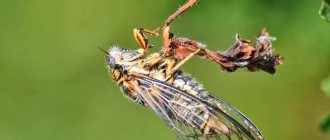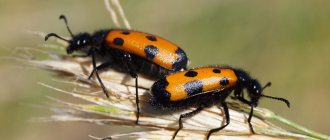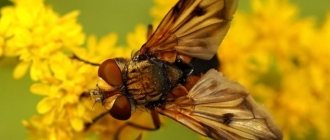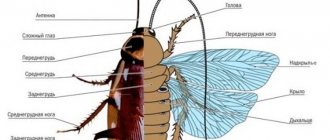- Where do bees live
Perhaps the bee is the most useful insect on our planet, because thanks to it, people have had the opportunity to enjoy honey since ancient times. Even in ancient times, people learned to specifically breed bees, and the honey obtained with their help has served for centuries as a favorite sweet treat, medicine, and an important ingredient in the creation of alcoholic drinks, such as mead, which was very popular even among our distant ancestors during the times of Kievan Rus. So, since ancient times, the bee has been a faithful friend of man and this is our article for today.
Description, structure, characteristics
According to the zoological classification, the bee belongs to the stinging family, the order Hymenoptera, and its closest relatives are wasps and ants.
The color of the bee is well known; it consists of a black background with yellow spots. But the size of a bee, depending on its type and class, can range from 3 to 45 mm.
The structure of an insect’s body can be divided into three parts:
Types of bees
There are a huge number of bee species known. In total, there are more than two tens of thousands of them all over the world. All bees are divided into two categories: domestic and wild.
It is no secret that people have been breeding these insects to produce honey since time immemorial. But not only it, but also other valuable substances: propolis, wax and medicinal poison. But wild bees .
They are somewhat smaller in size. Their color should be called primitive, its shades are not very bright, rather muted, and the color schemes are mostly monochromatic. The chest of savages is equipped with a protective shell.
The hairs on their body grow much thicker than those of their domesticated counterparts, playing the role of a coat of insects that saves them during periods of bad weather and cold weather.
The size of wild bees is much smaller than that of domestic bees.
Of the vast varieties of the bee kingdom, it is worth highlighting the most interesting. And the first ones that need to be mentioned are real bees. This is the name of a whole family, which includes about five thousand varieties. Among them:
1. Honey bees - most breeds of such bees have been used by people for a long time and are therefore well known to them. At first, our very distant ancestors simply found shelter for such insects in tree hollows and took honey from them. But gradually they began to breed them, keeping them in logs, either built from bark or made from clay.
Much later, houses for these honey-bearing creatures, called beehives, began to be built. And they invented easy-to-use frames. It is very easy to extract honey from such structures along with the honeycombs containing it.
2. Bumblebees are a whole genus of bees similar in many ways to their honey-bearing counterparts. In total, about three hundred species of such insects are known. They live on all continents of the Northern Hemisphere. Among their relatives, they have earned the reputation of being the most cold-resistant. By the way, this greatly increases their chances of survival.
Bumblebees have the opportunity to fly out to collect nectar in the early morning, when the rays of the gentle spring or summer sun have not yet warmed the air. In this way, they are ahead of their competitors and collect all the delicious things from flowers and other plants.
The outfit of each type of bumblebee is different. Some of them have yellow stripes alternating with black, while others have orange or red stripes. There are also completely dark varieties.
Bumblebees also belong to the bee family
Among the representatives of this insect kingdom there are real giants, which are noticeably larger than the bee to which we are all accustomed. A striking example of this are specimens of the genus Megachila. And their size is really impressive, because their wingspan can reach 6 cm. By the way, these bees are not capable of producing honey at all. They live in colonies and are famous for their particular aggressiveness.
In the photo there is a carpenter bee
Habitats
Bees live over a very wide geographic range, so it's easier to answer where bees don't live than where they do live. So, there are no bees only in those places where there are no flowering plants: hot sandy deserts and cold arctic tundras. In all other places there are bees.
As for the favorite habitats of these insects, they love to settle in mountain crevices, build their hives in the hollows of old trees and earthen burrows. It is important for bees that their habitat is protected from the winds and that there is a body of water nearby.
Pollinators
Bees are flowers' best friends. This may seem strange, since bees drink nectar and carry away most of their pollen. These actions are precisely that part of the joint life of flora and fauna. On which the survival of flowering plants on Earth depends. Like most living things, plants must reproduce. For this to happen, pollen must come into contact with tiny germ cells produced by the flower's pistil. Then and only then can the seeds of the plant ripen. This process is called pollination. The flower itself cannot do this; it is deprived of the ability to move. The best type of transport for carrying pollen is the furry bee, flying in search of nectar. For nectar, the bee climbs into the very cup of the flower, and the shaggy hairs that cover its body collect pollen on itself.
Usually the flower is quite crowded, and when the bee gets out, most of the pollen falls off. But now the pollen reaches those parts of the flower that need to be pollinated in order for the seeds to ripen. The bee provides the same important service to the trees. For example, pollen from male apple flowers must be transferred to female flowers. The flowers bloom in the spring and emit a sweet scent that attracts bees. Which fly from tree to tree to collect as much nectar as possible. Pollen from male trees sticks to the bee's hairy body and partially falls off. When a bee lands on the flowers of another apple tree. So if it weren’t for the bees, there would be no apples or apple trees.
Lifestyle
Bees are collective insects that live in large families - hives - and have a strict hierarchy and division of labor. The composition of a bee family includes:
- uterus,
- drone,
- worker bee.
In bee society, matriarchy reigns and it is the females who are entirely responsible for ensuring the life of the hive, while the males, also known as drones, exist only to procreate.
The queen bee is the queen of the hive, it is she who is responsible for the reproduction of offspring, she is also the creator of the hive and at first is engaged in its arrangement, until in this matter she is replaced by the worker bees that are born.
The task of male bees, drones, is only one - to fertilize the queen.
The entire economic life of the hive rests with worker bees, female bees incapable of sexual reproduction. They are the ones who hardworkingly collect nectar from flowers, protect the hive in case of danger, arrange its arrangement, transport honey, etc.
Bee nutrition
Almost all bees eat pollen and flower nectar. A special proboscis is used to extract it. Through it, the nectar enters the crop, where it is converted into honey. In the process of collecting pollen and nectar, flower pollination is of great importance. In search of plants, these insects are able to fly about 10 kilometers per day.
Lifespan
The lifespan of a bee directly depends on its place in bee society, as well as the time of birth.
How long does a worker bee live? Her lifespan is not long, and if she was born in spring or summer, it usually averages only a month. Such a short life expectancy is due to the hard work that the worker bee does to obtain nectar.
If a worker bee is lucky enough to be born in the fall, then she can live even six months, since she needs to survive the winter cold in order to be responsible for collecting honey in the spring and take part in its accumulation.
The lifespan of a drone is even shorter than that of a worker bee; two weeks after birth, it already becomes capable of fertilizing the uterus, and what is most interesting is that a few days after this very fertilization, drones usually die. It also happens that with the end of the honey collection period and the onset of winter cold, worker bees at this point drive out the drones that are no longer needed from the hive, after which they also die.
The queen bee lives the longest in the bee community. Typically, the average lifespan of a queen is 5-6 years, but for this she needs to be a valuable female and regularly give birth to new offspring.
What to do if you are bitten by a bee?
The sting of this creature is located at the end of the abdomen. It has a notch, due to which this insect is not able to survive an enemy attack. The bee's sting gets stuck in the enemy's body, and the helpless creature loses it, which causes the death of the brave defender of the nest.
But the victim himself, who received a portion of the poison, also acquires additional problems from bee loss. After all, the sting can get stuck in the skin and continue to release harmful substances.
The venom of this insect is very effective in composition. At first, the victim feels pain from its action. Then the site where the sting is inserted turns red, then a very unpleasant swelling appears, which subsides only after several (usually two or three) days.
In addition, foreign substances that enter the blood can cause an allergy attack. But at the same time, a bee sting can be useful. After all, the poison of these insects in small doses is endowed with healing properties. It kills bacteria and, in addition to harmful ones, contains many useful substances.
If a person has been attacked by this insect, he should first remove the sting, and then treat the affected area with potassium permanganate or any other antiseptic. Cold compresses also greatly promote healing. In addition, drinking plenty of fluids is beneficial, as it activates the removal of toxic ingredients.
Reproduction
Natural reproduction of bees is carried out by laying eggs by the queen, and she can lay eggs both after fertilization by a drone, and without it, with the difference that drones appear from unfertilized eggs, and full-fledged individuals from fertilized eggs.
The path from an egg to a full-fledged bee goes through several stages: first, the egg turns into a larva, then into a pre-pupa and a pupa, from which an adult bee is already formed.
When a bee colony reaches a large size, it divides - swarming. Some of the bees remain in the old place with the old queen, and some with the new queen go to build and equip a new hive.
Scientific classification
Bees have a long proboscis, which they use to suck pollen from plants. They also have antennae (or antennae)
,
siazhki
), each of which consists of 13 segments in males and 12 segments in females. All bees have two pairs of wings, the back pair being smaller in size than the front; only in a few species of one sex or caste the wings are very short, making the flight of the bee difficult or impossible.
Many species of bees are poorly studied. The size of bees ranges from 2.1 mm in the dwarf bee (Trigona minima) to 39 mm in the species Megachile pluto, found in Indonesia.
The name “bees” (Latin Anthophila) characterizes an entire group (section) of organisms that is part of the superfamily Apoidea of the order Hymenoptera (Latin Hymenoptera).
This section includes seven families, one of which is the family of real bees (lat. Apidae). Honey bees (lat. Apis mellifera L.) belong to this family.
Interesting Facts
- There are many myths and legends associated with bees; for example, according to the beliefs of the ancient Egyptians, the soul of the deceased left a person in the form of a bee.
- Even primitive people noticed that bee nests were valuable prey, and as a result they hunted for them. But this was a dangerous and difficult task, since the bees could sting the unlucky honey miner to death.
- In ancient Greece, beekeepers first learned to insert partitions into bee hives and use them to collect excess honey reserves. And the beginning of “scientific beekeeping” was laid by the great philosopher and scientist of antiquity, Aristotle.
- The famous ancient Greek physician Hippocrates wrote a whole scientific treatise on the benefits of honey for human health, and according to legend, a swarm of bees settled on the grave of the famous doctor, producing special healing honey that helps against many diseases.
Protection from enemies
The honey bee has only one weapon against dozens of enemies; having stung cattle or humans, it immediately dies, since its stinging apparatus remains in the enemy’s body.
However, if a hornet or an ordinary wasp tries to attack it, having stung them, it can easily return its sting to its original place. Enemies often lie in wait for bees when they return to the hive with nectar or pollen. They catch them and take them to the nest to feed the larvae.
Video
And finally, an interesting documentary about bees – “Tales from the Hive”.
Author: Pavel Chaika, editor-in-chief of Poznavaika magazine
When writing the article, I tried to make it as interesting, useful and high-quality as possible. I would be grateful for any feedback and constructive criticism in the form of comments on the article. You can also write your wish/question/suggestion to my email [email protected] or Facebook, with respect, the author.
Author page
Benefits of bees
Bees make a great contribution to the natural process of pollination - they pollinate plants better than other insects. One insect can process 3 million flowers in a day.
These insects produce products that are very valuable for the human body. Honey, wax, pollen, propolis, royal jelly and other bee products are widely used in cooking, cosmetology, folk and official medicine. They are natural antibiotics and help prevent the growth and development of harmful microbes in the body. And, what is especially important, these products act selectively, destroying only pathogenic microflora.
Important! Despite all the benefits, the bite of these insects poses a potential threat to humans. If after a bite you experience a severe allergic reaction or a deterioration in your general condition, you must immediately take an antihistamine and call an ambulance.
So, you should no longer have any questions about bee identification. Now you know that these unique creatures can be called both insects and animals. But since in everyday life the term “animals” refers only to mammals or four-legged land vertebrates, then bees should not be called that. After all, no one will say that, for example, mosquitoes and butterflies are animals.
